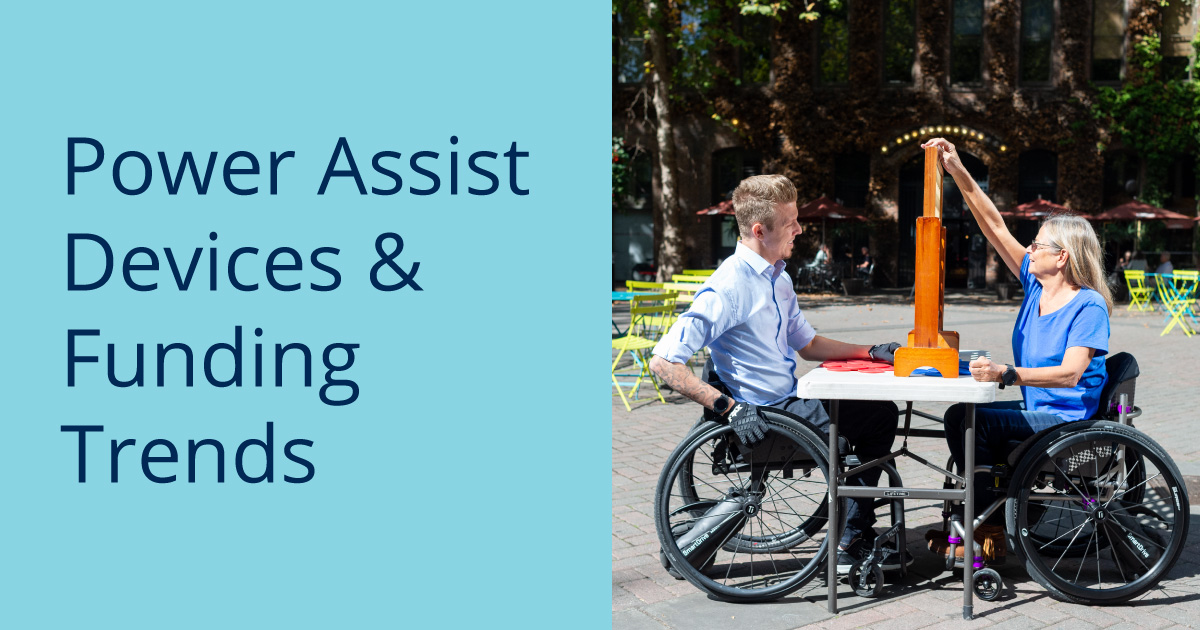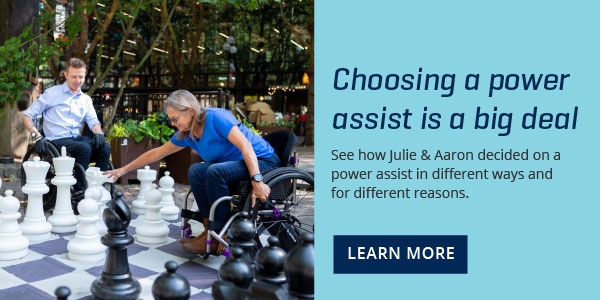The last part in our 4 part series about Power Assist Devices. See Part 1, Part 2, and Part 3.
For the final post in this series, we will be focusing on the funding trends and considerations for power assist devices. These past few weeks we’ve talked about all the great applications of power assist devices, but how do we get this piece of equipment for our clients? Coverage for power assist devices varies based on the funding source. Let’s look at the most common funding sources and how power assist devices are typically covered.
Medicare
For someone to meet medicare qualifications for a power assist device, they must:
 |
Meet the general coverage criteria for a power mobility device. This includes: |
|||||
 |
A significant mobility impairment that impairs the ability to complete mobility related activities of daily living (MRADLs), whether completely, safely, or within a reasonable time frame | |||||
 |
The mobility impairment cannot be resolved with a cane or walker | |||||
 |
The individual has insufficient arm function to self-propel an optimally configured manual wheelchair in the home for completion of MRADLs | |||||
 |
Have been propelling a manual wheelchair for at least one year |
|||||
 |
Participate in an evaluation by a licensed medical profession, most often an occupational or physical therapist |
|||||
 |
Have an Assistive Technology Professional (ATP) from an equipment provider involved in the evaluation process (CMS, 2017). |
|||||
A power assist device is considered a capped rental item under Medicare. A capped rental item is rented to the beneficiary for 13 months, with the equipment provider being reimbursed by Medicare on a monthly basis. After 13 months, the beneficiary then owns the device.
Because Medicare is concerned about in-home use only, you must think about medical justification for the power assist device from this standpoint. It is also important to include specific medical needs and objective measures when possible. For example:
- Is the client unable to navigate a ramp to get into the home independently, safely, and efficiently?
- Is there high pile carpet within the home that makes propulsion inefficient or impossible?
- Does mobility without the power assist take more than a reasonable amount of time and result in incontinent episodes?
- Must the individual carry items during wheeled mobility for completion of MRADLs (e.g., laundry basket or food items for meal preparation)?
When thinking through documenting medical need, consider:
- Is there a history of pain?
- Does the client have limited strength or range of motion?
- Is cardiopulmonary insufficiency a factor that disrupts your client’s ability to complete daily tasks?
- Is fatigue a limiting factor for you or your client?
Any objective information that can be provided to support the medical need will be helpful. A pain scale, manual muscle testing scores, rate of perceived exertion, oxygen saturation pre/post propulsion, Wheelchair Propulsion Test, and Fatigue Severity Scale are just a few examples.
Medicaid
Medicaid coverage criteria will vary from state to state and is typically the payor of last resort. Some state Medicaid’s follow Medicare guidelines while others consider not only in-home needs, but community mobility needs as well. For more information on your state Medicaid and possible power assist device coverage, contact US_Funding@permobil.com.
Private insurance
Much like state Medicaid programs, funding for power assist devices through private insurances varies greatly. In general, there is a trend of private insurances covering power assist devices when there is a documented medical need (see above under Medicare section). Some private insurances follow Medicare guidelines quite closely and will consider in-home needs only, while others will consider community mobility needs.
Alternative Funding Options
If insurance coverage has been pursued and denied, or is unavailable, consider an alternative funding source. A few to consider:
- Crowd source funding: Many of us are familiar with GoFundMe. There are also crowd source funding sites specifically designed for fundraising to support medical needs. Does you or your client have a supportive community that wants to help? This could be a great option!
- Vocational rehabilitation program in your state
- Consider foundations, such as the Permobil Foundation, or other non-profits that may be willing to support uncovered medical expenses
- Self-pay: Some equipment providers offer CareCredit for individuals who are interested in self-paying but need to make payments over time
Justifying a Power Assist Device
The big thing to remember here is tying the impairment in the individual’s body functions and structures to their inability to fully participate in MRADLs and life roles and how the power assist device will result in improved participation. Use of objective tests and measures showing why the client requires power assist for safe and efficient mobility will further support the justification.
If you are in need of some justification help, we have several resources.
- LMN Generator: Once you create a quick login, you will have access to sample language for justification of power assist devices amongst other complex rehab technology products. It is important to note this is starting language and must be made specific to your individual clients’ needs.
- If you have specific questions, please reach out to US_Funding@permobil.com and we'll do what we can to help you!
We hope you enjoyed our 4-part series on power assist devices. Our education team is here to help if you have any questions or concerns on power assist devices. Email us at education@permobil.com with any questions or concerns.
References:
Centers for Medicare and Medicaid Services (CMS). (2017). Local Coverage Determination (LCD): Power Mobility Devices (L33789). (2017). Retrieved from https://www.cms.gov/medicare-coverage-database/view/lcd.aspx?LCDId=33789&ver=31&Date=&DocID=L33789&bc=hAAAAAgAAAAA&
 Angela Regier, OTD, OTR/L, ATP/SMS
Angela Regier, OTD, OTR/L, ATP/SMS
Clinical Education Manager ‑ Western Region
Angela Regier, OTD, OTR/L, ATP received her doctorate of occupational therapy from Creighton University in 2007 and is a RESNA-certified assistive technology professional. Regier joined Permobil in 2017 as a Clinical Education Manager for the western region. Prior to joining Permobil, Regier was at Craig Hospital in Englewood, Colorado where her career focused on inpatient and outpatient spinal cord injury rehabilitation. Prior to leaving Craig Hospital, she was supervisor of the Wheelchair Seating and Mobility Clinic where she provided comprehensive seating and mobility interventions for individuals with acquired brain and spinal cord injury. Regier has published and speaks on the topic of seating and mobility for acquired brain injury and spinal cord injury. She has also served as an adjunct faculty for the Creighton University Entry-Level Distance OTD Program (Regis) in Denver, Colorado.

 Curtis A. Merring, ORT, MOT
Curtis A. Merring, ORT, MOTDirector of Market Development, Manual Products
Curtis A. Merring, OTR, MOT received both his undergraduate psychology degree and masters in occupational therapy at the University of Pittsburgh. While at university he was involved in research on multiple studies dealing with psychosocial disorders, wheelchair seating, and neurological recovery of the upper extremity for stroke patients. As an occupational therapist and researcher for the past 9 years he was responsible for treating and investigating spinal cord injury and stroke. This included being awarded multiple small grants and coordinating research projects between the clinic and local universities. Curtis has also worked as a Director of Therapy Services in the geriatric setting including opening and managing rehabilitation departments at multiple locations. During his time as a director he developed a program called “Seating System Management in Skilled Nursing Facilities and Long Term Care”, that was a continuing education course he taught to facilities in both Texas and California. The goal of the course was to improve the seating systems of a very underserved population. Curtis is currently the Director of Market Development, Manual Products.

